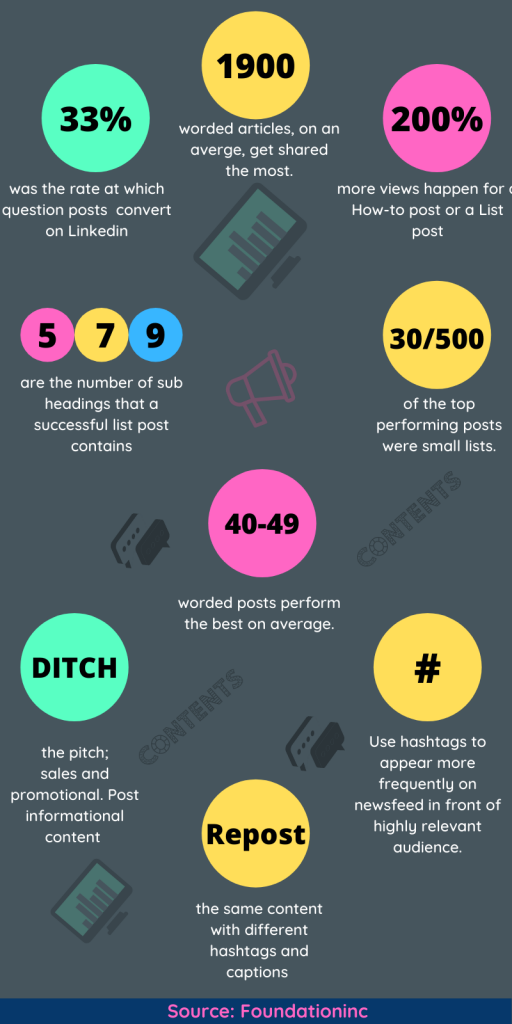Got great content, but you do not know how to implement a Linkedin content distribution strategy, right?
Been there!
For the B2B content marketer, you, Linkedin is what the fertile, luscious plains of Napa Valley are for wine aficionados.
Lips-smacking quality and a quantity that spoils one with choices.
On Linkedin, there are more than 61 million influencers who post content regularly for their network and active 40 million decision-makers from Wall Street, Madison Street, Silicon Valley and their likes from around the world.
The quality, format and tone of content you need to voice out is easily evident when you scan Linkedin’s newsfeed.
However, the best practices for Linkedin content distribution are not practised often.
What are the various channels in Linkedin to promote content? What are the best practices to distribute content on Linkedin? How do I know that my Linkedin content distribution is justifying the mindnumbing research and post/share button I continuously tapped?
In this blog post, we up your ante on distributing content on Linkedin.
Why content distribution on Linkedin is important?
For starters, 94% of B2B content marketers have ranked Linkedin as their #1 platform for content distribution.
Blasting information, aggressively but mindlessly, is dead. Today’s consumer (read, CEOs, CMOs, HRs) is really picky in choosing the content to consume. Along with their decreasing attention span, consumers are also in ever-changing environments.
Successful content marketing always gets two things right simultaneously:
- Content
- Context.
So, in order to get noticed by one among the 40 million-odd decision-makers, you have to create great content and regularly ( I repeat, REGULARLY) cast it, again regularly, at the right time. The latter part is where it gets tricky.
About 90% of Linkedin’s users are passive ones; they just scroll the newsfeed for content and do not actively engage with content. In order to be that content that gets any remark, you have to plan a distribution strategy that tells the right story at the right time.
Even Linkedin’s editorial mission statement is to provide professional and relevant, timely content to users.
How Linkedin Content Distribution Works
Like any other social media platform, Linkedin content distribution works based on algorithms- Dwell algorithm, FollowFeed etc, which move the wheels of the content you post.
Linkedin is very open about how content is moderated, classified and distributed. In its engineering blog, Linkedin reveals how every piece of content is distributed by its algorithm. For a post to appear on your follower’s newsfeed, Linkedin makes content distribution decisions based on insights from statistical models that adjudicate the virality of the content, classifiers that are trained to identify low quality, spammy posts and the rate at which engagement occurs within the content creator’s personal connections.
In addition to this, Linkedin adopts a man-machine based approach to content moderation. This means that there are actual humans who cuddle around the cauldron to classify content on a real-time basis. This is why the editorial standards of your post-grammar, formatting- is extremely important. Humans have biases and you wouldn’t want to mess up your chances at scoring a lead because of your poor grammar. Moreover, two moderators may have issues on agreeing that a post is of good quality.
Linkedin itself makes recommendations on what it considers as quality content.
Moreover, Linkedin’s algorithm is more niche based. It takes into account, reader’s personal information such as their headlines, summary and experience before determining if the content will be relevant for them.
The latest factor that affects content distribution on Linkedin is Dwell time. In May 2020, Linkedin Engineering blog featured a post that explained the implications of users spending more/lesser time on your post. According to this feature, Linkedin calculates the amount of time you spend on a piece of content and passes a judgement that impacts on the content’s visibility on the platform. Linkedin believes that engagement such as likes and reactions, read more may cause some bias and manipulation. The user may just engage and bounce off the post. To counter this, the amount of time the reader spends on a post is considered while distributing content on Linkedin.
Now now, you don’t fuss too much over the algorithm while creating content. These features were just introduced to let you know that the tactics that we provide satisfy these very features and work well for promoting content on Linkedin.
Tips to promote content on Linkedin
Before we let you in on content distribution on Linkedin, hear a few tips from us on crafting quality content for Linkedin. The theory for creating content might have drained you.
Let us shower you with actionable tips on what makes good content on Linkedin:

To summarise:
- Create articles that are 1900 words long with 5 or 7 or 9 subheadings.
- Solve your reader’s problems using How-to posts and list posts through Linkedin posts and articles.
- Spend time researching and testing out hashtags and leverage them on LinkedIn.
- For Linkedin posts, small How to posts work the best. Make sure you repost them at various intervals of the day.
Now for the long-awaited strategies on distributing content in Linkedin…
7 effective ways to distribute content on Linkedin
To be honest, distributing content on Linkedin is fairly easy. You just have to find the various places on Linkedin you can post an image, video or link on and be done with it. However, that is just for dummies and newbies.
Effective content distribution for Linkedin starts with extensive research to identify where your target audience is on the platform. In order to uncover ground-breaking insights and hack content distribution on Linked, we empower you with some techniques to do research here. Also, we provide you with various channels in LinkedIn you can take advantage of to promote your content.
Linkedin groups
One of the best ways to grow on Linkedin is to distribute content on the 2 million active Linkedin groups.

According to Linkedin, you are 70% more likely to get an appointment if you cite a mutual Linkedin Group to your connection.
Linkedin groups are huge and are based on niche. People join groups according to their interests and their identity. In marketing terms, they already do segmentation for you to distribute content on Linkedin.
Linkedin groups also breakdown the demographics of the group. Using these stats you can power your content with personalization. You can cater to the problems and questions to the firmographics and career positions of the members of the group.
A good Linkedin content distribution strategy is definitely not going to be one that is left untracked. In order to measure your content distribution on Linkedin groups, you can use UTM parameters from Google Analytics.
Linkedin Hashtags
Linkedin hashtags are a great feature to promote content on Linkedin. Of late, LinkedIn allows you to follow hashtags. By catering to the needs of the people following the hashtag, you can take your Linkedin content distribution to another level.
To be honest, hashtags are either underrated and often overexploited. I personally blame Instagram for this. Linkedin content distribution can be hacked using highly researched hashtags.
How do hashtags work?
When you use hashtags in your Linkedin post, your post gets grouped along with the tons of other content that use the same hashtag. Usually, people follow hashtags to get content relevant to their personal interests. Similarly, on Linkedin, people follow hashtags to follow content relevant to their business, goals, personal motivations.
How to distribute content using hashtags?
First, treat hashtags like keywords. Research popular hashtags. Analyze people who follow these hashtags. Check the format and topic of the content posted under these hashtags. Ask your peers, LinkedIn connections about the popular hashtags they follow.
Like how keywords have search intent, hashtags too have a very specific intent. Your content should resonate with the intent of your users.
Just like keywords these hashtags can also be divided into location-based hashtags, niche-based hashtags, job-based hashtags, day based hashtags, trending hashtags, broad hashtags, event hashtags etc.
Once you do that map your Linkedin posts with appropriate hashtags.
Hootsuite has got a great list packed with popular hashtags.
Linkedin search operators
Who said only recruiters and salespeople should use the boolean?
Content distribution on Linkedin can be heavily personalized and made more effective by using Linkedin search operators.
Boolean search operators have been around for a decade. But few to none have exploited the power of search operators for promoting content on Linkedin.
Below we list the most used search operators:
- ” “- Enclosing search queries within double quotes results in exact match in the search results. For example, if I want to distribute this blog post, I would search, “B2B marketer” on the Linkedin search and develop a relationship and then promote this blog post to my fellow B2B marketers.
- AND- The AND operator makes sure your search satisfies all the conditions mentioned in your search query. For eg, a search for Marketing AND SEO would yield profiles that use both marketing and SEO in them.

3. OR- Using the OR operator you can forage results that satisfy at least one condition specified in your search query. For eg, a search with marketing OR SEO would be like this.

4. NOT- The NOT operator is used to exclude results from a search query. For eg, (“SEO” OR “advertising”) AND (“content writer”) NOT (“recruiter”) would remove results that contain the term recruiter.
5. Parentheses- Enclosing search queries within parentheses allows you to perform more specific searches as you can group, several operators, together.
For eg, a search for (“SEO” OR “advertising”) AND (“content writer”) would yield,

How do search operators matter for content distribution on Linkedin?
See, content distribution works its magic only when you establish authority and credibility through building great relationships. You can cold message each of these results about your content or you can warm them up by personally emailing them about the work you do, ask them about their experience in their current company, about their school and then sending them the content you have created if you think it will interest them.
These search operators will help you in narrowing down your target audience for each piece of content you create based on company, position, experience and location.
Linkedin Company Pages
Did you know that your employees are 14x times more likely to share your companies content than your followers?
Distributing content through Linkedin company pages are one of the best practices for promoting your content. At least, I and Neil Patel, personally believe so.
Once you post content on Linkedin using your company profile, your employees are notified. This allows them to share your content on sight, and amplify your content’s reach.
Influencer marketing
Product endorsements by celebrities, doctors and scientists are always revered by customers. The psychology behind is that the attributes, traits, personal characteristics and authority on the subject matter are subconsciously passed over to the product as well. This strengthens the brand associations and shapes public opinion.
How about doing the same for Linkedin content distribution?
Influencer marketing for LinkedIn content distribution is encouraged because of the credibility and trustworthiness that is endowed when an influencer endorses the content.
Gone are the days when ads can be relied on to change public perception. Consumers have become ad-blind. They yearn for content that is already stamped with a mark of quality.
Linkedin alone has more than 90 million senior-level influencers; 63m decision-makers and 17m opinion leaders.
Content distribution across the buyer cycle
That is what Linkedin influencers do for you. B2B product cycle is longer than B2C. Your influencer can be asked to endorse different content that can be distributed across the buyer’s journey- blog posts for awareness, ebooks, white papers, case studies for consideration and product features and reviews during the decision stage.
Moreover, Linkedin influencers are celebrated for their authority and credibility. They basically feed off their own reputation and a carefully shaped brand image. Hence, they are hell-bent on endorsing products and content that are useful for their followers.
If you manager doesn’t believe in paid content distribution using Linkedin’s ad platform, then you can ask influencers for a paid content distribution collaboration.
Linkedin automation
Incorporating automation in your Linkedin content distribution massively speeds up your content marketing efforts. 89% of marketers consider marketing automation to benefit their marketing efforts.

What a Linkedin marketing automation tool, can do for you is automate the above processes such as
- Building relationships with influencers
- Replace search operators
- Automate messages to your target audience informing them about your brand new valuable content.
- Segment your relationships using a CRM
Distributing content on LinkedIn becomes easier with automation.
Ideating, writing and research for promoting content on Linkedin sometimes take forever to implement. But these are the creative tasks that you would want to lend your sharp focus on.
Don’t judge us for bias, but we both know automation is here to stay. And you know what is that one more thing we can agree upon?
Automation saves a hell lot of time!
The Conclusion: Build relationships
In his book, Adweek copywriting handbook, Joseph Sugarman shares an interesting anecdote of how a friendly neighbourhood salesman, Howard, sold him life insurance. In the story, Howard did not go all out with his sales acumen on one of the greatest admen of all time. Instead, he continuously reminded Sugarman about life insurance. Since Howard knew that Sugarman handled an ad account for a calculator manufacturer, he sent interesting, useful news clippings on calculators along with his business card.
One day Sugarman’s neighbour passed away. It was sudden. Sugarman reflected on the situation and realized how precarious life is. He realized he wanted to offer more security to his family. Guess what he did?

Howard’s relationship with the latter made him decide that he was the go-to person for life insurance.
Yes, there are more than 600+ million Linkedin users on Linkedin. Yes, they want the best information, best tools, best deals, best jobs. Yes, they are greedy for growth, generous with engagement, guilt-free in consuming free content. But why should they get it from you?
This is why building relationships is crucial. In order to make your content promotion and distribution efforts successful, you have to:
- Segment your leads. Send a personalized connection message.
- Personalize your content for your target segments.
- Share the content with them
- Follow up
- Get feedback from your leads about your content
Valuable relationships are those that lead to clicks, conversions and sales.





